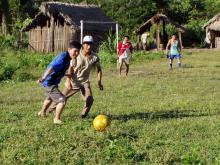
Low Testosterone Level in Amazonian Tribe Responds to Competition, According to Anthropologists at UCSB

As part of an isolated indigenous group in central Bolivia, Tsimane men spend much of their time hunting, foraging, fishing, and clearing land by hand to grow crops. Their ability to maintain the physical activity required to survive each day might imply they have higher than average male testosterone levels.
Anthropologists at UC Santa Barbara and the University of Washington have found, however, that the baseline testosterone level of Tsimane men is 33 percent lower than that of men living in the United States, where life is physically less demanding. Also, in contrast to men in the U.S., the Bolivian foragers-farmers do not show declines in testosterone as they age. The researchers' findings appear today in the Proceedings of the Royal Society B.
According to Michael Gurven, the lives of the Tsimane offer a glimpse of how humans survived before industrialization and modern amenities. "Our lifestyle is now an anomaly, a major departure from our species' long-term existence as hunter-gatherers," said Gurven, professor of anthropology at UCSB and co-author of the paper. Gurven is also co-director of the Tsimane Health and Life History Project, a collaboration between UCSB and the University of New Mexico.
"Maintaining high levels of testosterone compromises the immune system, so it makes sense to keep it low in environments where parasites and pathogens are rampant, as they are where the Tsimane live," said Ben Trumble, a graduate student in anthropology at the University of Washington, and the paper's lead author.
That men living in the U.S. have greater levels of circulating testosterone represents an "evolutionarily novel spike," Trumble continued. The spike reflects how low levels of pathogens and parasites in the U.S. and other industrialized countries allow men to maintain higher testosterone levels without risk of infection. He also pointed out that while men in the U.S. show a decline in testosterone as they age, and the drop serves as a sentinel for age-related disease, Tsimane men maintain a stable testosterone level across their lifespan, and show little incidence of obesity, heart disease, and other illnesses associated with older age.
Despite lower levels of circulating testosterone under normal conditions, the forager-farmers do have something in common with U.S. men –– short-term spikes of testosterone during competition.
The researchers organized a soccer tournament for eight Tsimane teams, and discovered that Tsimane men experienced a 30 percent increase in testosterone immediately after a soccer game. An hour after the game, testosterone was still 15 percent higher than under normal conditions. Similar increases have been shown in men living in the U.S. or other industrialized countries following, sports competitions.
The study suggests that competition-linked bursts of testosterone are a fundamental aspect of human biology that persists even if it increases risk of sickness or infection. "What's interesting is that in spite of being in a more pathogenic environment, it's still important to raise testosterone for short-bursts of energy and competition," Gurven said.
As to whether higher levels of the male hormone would offer a competitive advantage in sports, Trumble suspects that because U.S. men are "taller and weigh more than Tsimane men, and tend to be exposed to fewer parasites and pathogens, they would probably have a competitive advantage, regardless of circulating testosterone."
Other co-authors of the paper include Christopher von Rueden, a post-doctoral scholar and researcher in the Department of Anthropology at UCSB; Kathleen O'Connor and Eric Smith of the University of Washington; and Daniel Cummings of the University of New Mexico.
The work was funded by the National Institute of Child Health & Development and the National Institute on Aging.
Related Links



